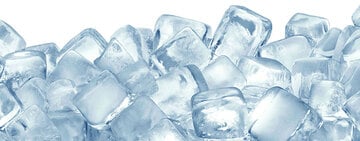
From flakes to cubes, ice comes in many forms. This isn't just for aesthetic purposes; the shape and size of ice determine its ideal application. Educate yourself on the intended purpose of each type of ice, so you can select the best ice machine for your establishment.
Shapes of Ice
Ice Cube Styles
Every ice cube style serves a particular purpose. Some are made to cool drinks, while others are produced for chewing or product display. Below, we explain the characteristics of each style of ice, their common applications, and their benefits.
Regular Ice Cube
Regular ice cubes are commonly found in commercial settings including restaurants and bars. Thanks to their larger size and slower melting rate, regular ice won't quickly water down your soft and mixed drinks. They're also a good option for bagging and dispensing applications.
- Also Known As: Large Cube
- Characteristics: The regular ice cube features a solid build and contains a nearly 100% ice-to-water ratio.
- Size: 1 1/8" x 1 1/8" x 7/8"
- Melt Rate: Slow
Full Cube Ice
Full ice cubes are uniform and provide a clean look. Due to the larger size and slower melting rate, full ice cubes offer maximum cooling while saving money by reducing ice consumption. These are best for ice bagging and dispensing, as well as soft drinks and mixed drinks. They're commonly found in restaurants, bars, convenience stores, and catering businesses.
- Also Known As: Dice Ice or Square Cube
- Characteristics: The full ice cube features a solid build and contains nearly a 100% ice-to-water ratio.
- Size: 7/8" x 7/8" x 7/8"
- Melt Rate: Slow
Half Cube Ice
Half cube ice is a great, universal application ice style. They're found in most restaurants, bars, and convenience stores. They provide maximum cooling without watering down drinks too quickly, making them great for smoothie shops and for soft drinks, mixed drinks, and frozen cocktails. They're ideal for ice bagging and self-service dispensing.
- Also Known As: Half Dice or Small Cube
- Characteristics: The half ice cube is known for its convenient size. It features a solid build and contains a nearly 100% ice-to-water ratio.
- Size: 7/8" x 7/8" x 3/8"
- Melt Rate: Moderate
Nugget Ice
Nugget ice absorbs the flavors of drinks and is easy to break down when chewed. It blends well and cools drinks rapidly. It's commonly found in healthcare facilities, restaurants, bars, and convenience stores. This ice is best for soft drinks, cold drinks, and blended drinks like magonadas and frozen cocktails. It can also be provided on its own for medical facility patients to chew.
- Also Known As: Tubular Nugget Ice, Pebble Ice, Pellet Ice, or “Sonic” Ice
- Characteristics: Nugget ice is soft, making it easy to chew, while still being hard enough to dispense.
- Size: 3/8"-1/2" in length and width, Bite-Sized
- Melt Rate: Quick
Flake Ice
Due to its soft consistency, flake ice is gentle on produce and fragile seafood in displays or food transport to prevent bruising. The softness is also ideal for compressing injuries as it cools without adding too much pressure. It's commonly found in grocery stores, fish markets, buffets, and healthcare institutions. This ice is primarily for display applications to present seafood, meats, and produce in market display cases or buffet lines. It is also often used for medical compresses or in blended drinks.
- Also Known As: N/A
- Characteristics: Flake ice is soft and snow-like, featuring a 73% ice-to-water ratio. It cools rapidly and can be easily molded.
- Size: Varies
- Melt Rate: Quick
Crescent Ice
Due to its unique shape, crescent ice can move in a glass without packing together. It shapes itself to the sides of a glass, creating exceptional liquid displacement and easy flow as a customer enjoys their beverage. This ice is best for ice bagging and dispensing, as well as soft drinks and mixed drinks. It's used in commercial kitchens, bars, and convenience stores.
- Also Known As: N/A
- Characteristics: Crescent ice has a distinct half-moon shape and features a solid build.
- Size: 1 1/2" x 1 1/8" x 1/2"
- Melt Rate: Slow
Gourmet Ice
Due to its unique shape and large size, gourmet ice cools drinks and offers an eye-catching presentation. It's crystal clear and elegant without watering down drinks. Gourmet ice is best for serving in high-end liquors and upscale drinks like whiskeys or an old fashioned. Gourmet ice is found in upscale restaurants, bars, and banquet halls.
- Also Known As: Top Hat Ice or Octagon Shaped Ice
- Characteristics: Gourmet ice has a unique octagonal or cylindrical shape, features a solid build, and contains an almost 100% ice-to-water ratio.
- Size: 1 3/8" x 1 3/8" or 1 1/4" x 1 1/8" x 7/8" depending on shape
- Melt Rate: Slow
Whether you’re serving drinks or displaying food, ice is essential to your presentation. Restaurants, convenience stores, grocery stores, and bars must use the correct ice for their application to provide a positive customer experience and save money long-term.






